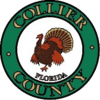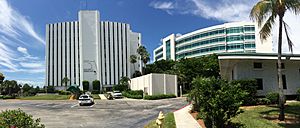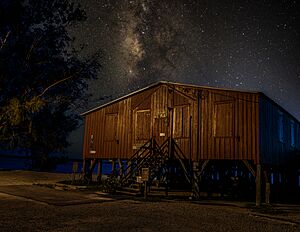Collier County, Florida facts for kids
Quick facts for kids
Collier County
|
|||||
|---|---|---|---|---|---|
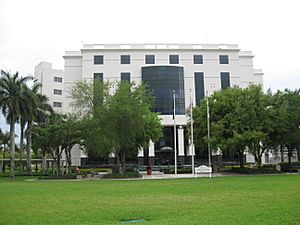
The Collier County courthouse in April 2010
|
|||||
|
|||||

Location within the U.S. state of Florida
|
|||||
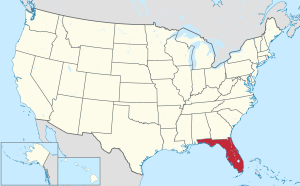 Florida's location within the U.S. |
|||||
| Country | |||||
| State | |||||
| Founded | May 8, 1923 | ||||
| Named for | Barron Collier | ||||
| Seat | East Naples | ||||
| Largest city | Naples | ||||
| Area | |||||
| • Total | 2,305 sq mi (5,970 km2) | ||||
| • Land | 1,998 sq mi (5,170 km2) | ||||
| • Water | 307 sq mi (800 km2) 13.3%% | ||||
| Population
(2020)
|
|||||
| • Total | 375,752 |
||||
| • Density | 188/sq mi (73/km2) | ||||
| Time zone | UTC−5 (Eastern) | ||||
| • Summer (DST) | UTC−4 (EDT) | ||||
| Congressional districts | 18th, 19th, 26th | ||||
Collier County is a county located in the sunny state of Florida. It's in the U.S. state of Florida. In 2020, about 375,752 people lived here. That's a lot more people than in 2010!
The main office for the county, called the county seat, is in East Naples. Before 1962, the county offices were in Everglades City.
Contents
History of Collier County
Early Settlers and Native Americans
Long ago, more than 2000 years ago, people lived in the area that is now Collier County. We know this from archaeological digs at Platt Island. When Europeans first arrived, the Calusa people lived here. They had a large and important presence in the area.
How Collier County Was Formed
Collier County was officially created in 1923. It was formed from a part of Lee County. The county got its name from Barron Collier. He was a rich businessman from New York City.
Barron Collier bought a lot of land in Southwest Florida. He became a very important landowner. He even agreed to help build a famous road called the Tamiami Trail. This road connects Tampa and Miami. In return, the state government agreed to name a county after him.
Barron Collier once said he never expected to own so much land. He also didn't expect to pay for the new Tamiami Trail. But most of all, he didn't expect to have a whole county named after him!
Geography of Collier County
Size and Location
Collier County is a very large county. It covers about 2,305 square miles. About 307 square miles of this area is water. It's the biggest county in Florida when you look at just the land area. It's also the fourth-largest county overall in Florida.
A big part of the county, especially in the southeast, is within the Big Cypress National Preserve. Also, the northern part of Everglades National Park reaches into the southern coast of the county. The town of Chokoloskee, Florida is also in Collier County.
To give you an idea of its size, Collier County is almost one and a half times bigger than the state of Rhode Island! It's even bigger than Rhode Island and the country of Luxembourg put together.
Neighboring Counties
Collier County is located on Florida's Gulf Coast. It shares borders with these other counties:
- Hendry County – to the north
- Broward County – to the east
- Miami-Dade County – to the southeast
- Monroe County – to the south
- Lee County – to the northwest
Protected Natural Areas
Collier County is home to several important natural areas that are protected:
- Big Cypress National Preserve (part of it)
- Everglades National Park (part of it)
- Florida Panther National Wildlife Refuge
- Ten Thousand Islands National Wildlife Refuge
Transportation in Collier County
Airports
Collier County has several airports, which are important for travel and local services:
- Everglades Airpark
- Immokalee Airport
- Marco Island Airport
- Naples Municipal Airport
- Dade-Collier Training and Transition Airport (mostly unused)
Main Roads
These are the major highways that run through Collier County:
 Interstate 75
Interstate 75 U.S. Route 41
U.S. Route 41 State Road 29
State Road 29 State Road 84
State Road 84 State Road 951
State Road 951
Population and People
| Historical population | |||
|---|---|---|---|
| Census | Pop. | %± | |
| 1930 | 2,883 | — | |
| 1940 | 5,102 | 77.0% | |
| 1950 | 6,488 | 27.2% | |
| 1960 | 15,753 | 142.8% | |
| 1970 | 38,040 | 141.5% | |
| 1980 | 85,971 | 126.0% | |
| 1990 | 152,099 | 76.9% | |
| 2000 | 251,377 | 65.3% | |
| 2010 | 321,520 | 27.9% | |
| 2020 | 375,752 | 16.9% | |
| 2023 (est.) | 404,310 | 25.7% | |
| U.S. Decennial Census 1790–1960 1900–1990 1990–2000 2010–2015 2020 |
|||
Population Growth and Diversity
Collier County has been growing a lot! Between 2000 and 2010, the population grew by almost 28%. The county is also becoming more diverse, meaning people from many different backgrounds live there.
In 2010, about 83.85% of the people were non-Hispanic White. About 25.9% were Latino or Hispanic. About 6.6% were African American, and 1.1% were Asian. The biggest reason for the population growth since 2000 was the increase in the Latino or Hispanic population.
2020 Census Information
| Race | Pop 2010 | Pop 2020 | % 2010 | % 2020 |
|---|---|---|---|---|
| White (NH) | 211,156 | 235,455 | 65.67% | 62.66% |
| Black or African American (NH) | 19,898 | 22,554 | 6.19% | 6.0% |
| Native American or Alaska Native (NH) | 609 | 551 | 0.19% | 0.15% |
| Asian (NH) | 3,390 | 5,419 | 1.05% | 1.44% |
| Some other race (NH) | 431 | 1,502 | 0.15% | 0.42% |
| Mixed/multiracial (NH) | 2,787 | 7,961 | 0.87% | 2.12% |
| Hispanic or Latino | 83,177 | 102,249 | 25.87% | 27.21% |
| Total | 321,520 | 375,752 |
In 2020, there were 375,752 people living in Collier County. These people lived in 140,578 households, and 97,279 of those were families.
Education and Libraries
Schools
The public schools in Collier County are managed by the District School Board of Collier County. They make sure students have good places to learn.
Public Libraries
The Collier County Public Library system has 10 different locations. These libraries serve everyone in the county. All locations offer computers with internet, printing, copying, and free Wi-Fi. You can also return books and videos any time of day or night using their drop boxes.
Communities in Collier County
Cities in Collier County
Other Communities (Census-Designated Places)
- Ave Maria
- Berkshire Lakes
- Chokoloskee
- Golden Gate
- Goodland
- Heritage Bay
- Immokalee
- Island Walk
- Lely
- Lely Resort
- Marco Shores-Hammock Bay
- Naples Manor
- Naples Park
- Orangetree
- Pelican Bay
- Pelican Marsh
- Pine Ridge
- Plantation Island
- Verona Walk
- Vineyards
- Winding Cypress
Other Unincorporated Communities
Images for kids
See also
 In Spanish: Condado de Collier para niños
In Spanish: Condado de Collier para niños



